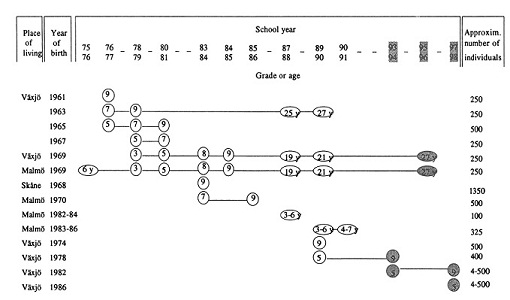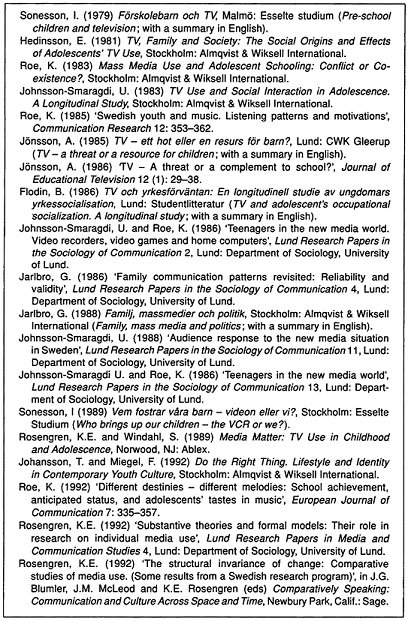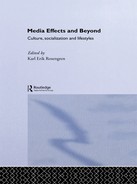Chapter 3
The Media Panel Program (MPP) and
related research
Karl Erik Rosengren
The Media Panel Program group dates its origin back to 1969, when two of its members, Professors Karl Erik Rosengren and Sven Windahl, started a series of studies focused on individual use of the media (see Rosengren and Windahl 1972, 1977). Gradually, a growing consensus emerged among the participants in the project about the necessity for a large, longitudinal study of media use among children and adolescents. There were several reasons for this, one being our interest in Individuals' mass media use, its causes and consequences, another, an equally strong interest in the interplay between those very basic agents of socialization, the family, the peer group, school, and the mass media.
In 1975, after a series of preliminary studies, the Media Panel Program (MPP) was established (Rosengren and Windahl 1978). Within the MPP group about a dozen researchers, originally trained within different disciplines and all having both common and differential research interests, have since 1975 been working together for shorter or longer periods of time.
Financially, the programme has enjoyed generous support – provided to the programme as a whole, as well as to a number of specific projects within the programme – from the following organizations:
The Swedish Council for Research into the Humanities and the Social Sciences
The Bank of Sweden Tercentenary Foundation
The Swedish National Board of Education
The Swedish Social Science Council.
The Universities of Lund, Gothenburg and Växjö have provided excellent working facilities and generous leaves of absence for research, as well as a number of graduate student grants.
Today, the MPP is an umbrella organization for senior and junior scholars and social scientists working within their own projects and forming a research group with a broad range of interests, namely:
To follow successive cohorts of children and adolescents as they move through time, gradually leaving their family of origin and approaching their own families of procreation, all the time being subject to a close interplay with and between a number of basic agents of socialization (family, school, working group, peer group, and the mass media), an interplay which shapes their lives and futures, at the same time as it itself develops over time, between generations, and under different societal conditions – among which, of course, the developments of society's media structure stand out as especially important.
A basic characteristic of the research within the MPP group is that it has not been limited to a given theoretical or methodological perspective, nor has it been dedicated to research on just one substantive problem within the wide theoretical area covered by empirical MPP data. On the contrary. Within the overall theoretical framework outlined in Chapter 1, at least four main theoretical perspectives have continuously been cultivated within the MPP:
•A developmental perspective.
•A social class perspective.
•A socialization perspective.
•A lifestyle perspective.
Our research has dealt with a number of substantive aspects of individual use made of mass media by children, adolescents, young adults and their parents, as well as the behavioural, attitudinal and structural causes and consequences of that use. As a matter of course, the media use under study has continually been related to the family and peer relations, the activities, and the school and work experiences of the children, adolescents and young adults under study. A simple model which has been used to organize the thinking within the MPP is rendered in Figure 3.1. More sophisticated models have been used, of course, in the various specialized studies produced within the programme.
In methodological terms, the MPP could be described as a series of quantitative and qualitative studies from 1975 onwards carried out on children, adolescents and young adults in two towns/cities in southern Sweden. The larger one, Malmö, with some 230,000 inhabitants, lies in the centre of a metropolitan area, with Copenhagen directly across the Sound between Sweden and Denmark; the smaller one, Vãxjö (some 65,000 inhabitants, situated in the southern inland of Sweden) stands out as something of a Swedish Middletown.
Together, they may be taken to represent a dominant segment of the Swedish population (see Chapter 2), but obviously, the sparse countryside population of Sweden is not included – except in the data collection wave called ‘Skåne 83/84’ which included also the countryside population of Sweden's southernmost landscape. (For information about media use among adolescents in the countryside population, as well as its causes and consequences, see, for instance, Johnsson-Smaragdi and Roe (1986), Roe (1992).)

Figure 3.1 Conceptual model of the socialization process

Figure 3.2 Design of data collection within the Media Panel Program
The data collection has been carried out within a combined longitudinal and cross-sectional design admitting both cross-sectional, longitudinal and diagonal analyses, thus making possible the analysis of three basic types of time-related effect: situational, maturational and cohort effects (Figure 3.2; see also Chapter 4). Since the data collection has been undertaken in two locations, we are in a position also to add spatial comparisons to the temporal ones. For logistical reasons the data collections in the two towns were as a rule undertaken during different semesters of the same school year.
The techniques used for data collection include mail and classroom questionnaires, personal interviews, essays written by school children at school, archival data, focused interviews, and long, in-depth conversations with a small number of type-representative individuals. For children and adolescents in grades 3–9 in the compulsory school system, classroom questionnaires were used, as a rule with an extremely high response rate. For older adolescents and young adults, as well as for parents, mail questionnaires were used, with response rates in the 70 and 80 per cent ranges. School grades and similar data were culled from school archives. All collection, storage and analysis of data has been undertaken with permission from, and in accordance with the rather strict regulations of the Swedish Data Inspection, an authority which quite rightly has repeatedly shown considerable interest in our work. (Further information about data collection etc. may be found in Rosengren and Windahl (1989) and in Johansson and Miegel (1992).)
During a long period of continuous research the MPP group has produced a data bank which to the best of our knowledge is unique, and in which a large mass of data related to individual media use, its causes, effects and consequences are stored, covering cohorts and panels of children and adolescents passing through the school system and into work or continued studies during their early adulthood. In all, the bank contains data about the following:
•Some 4,400 children, adolescents and young adults.
•Their family background, activities and relations.
•Their relations to peers and their school experiences (including school grades etc.).
•Their media use, lifestyles, present occupation and activities, as well as
•Their plans for the future.
Relevant information and data from their parents have also been collected on several occasions. If – as we hope – it will prove possible to maintain and update it properly, this data bank will for many years to come remain a rich resource for the study of a number of different relations between, on the one hand, children, adolescents and young adults, and on the other, their families (of origin and of procreation), school, peer group, mass media use, working position, etc. In future studies, it will become possible to study the kind of family life which these former youngsters are and will be leading as they gradually enter the phase of adult life and their own family of procreation.

Figure 3.3 Chronological list of some main publications within the Media Panel Program
The research undertaken has been reported in a great number of publications, local, national and international. Space does not permit even short summaries of these results. Results from the first three data collection waves within the MPP were presented in Rosengren and Windahl (1989). Results from later waves were presented in Johansson and Miegel (1992) and in a number of other publications. Figure 3.3 presents a list of the main publications produced by members of the MPP group during the last few years. Chapters 4 to 12 in this book offer numerous results from both early and later data collection waves undertaken within the MPP.
REFERENCES
Johansson, T. and Miegel, F. (1992) Do the Right Thing. Lifestyle and Identity in Contemporary Youth Culture, Stockholm: Almqvist & Wiksell International.
Johnsson-Smaragdi U. and Roe, K. (1986) ‘Teenagers in the new media world’, Lund Research Papers in the Sociology of Communication 2, Lund: Department of Sociology, University of Lund.
Roe, K. (1992) ‘Different destinies – different melodies: School achievement, anticipated status, and adolescents' tastes in music’, European Journal of Communication 7: 335–357.
Rosengren, K.E. and Windahl, S. (1972) ‘Mass media consumption as a functional alternative’, in D.McQuail (ed.) Sociology of Mass Communications, Harmonds-worth: Penguin.
Rosengren, K.E. and Windahl, S. (1977) ‘Mass media use: Causes and effects’, Communications 3: 336–352.
Rosengren, K.E. and Windahl, S. (1978) ‘The Media Panel Program: A Presentation’, Media Panel Reports 4.
Rosengren, K.E. and Windahl, S. (1989) Media Matter: TV Use in Childhood and Adolescence, Norwood, NJ: Ablex.
